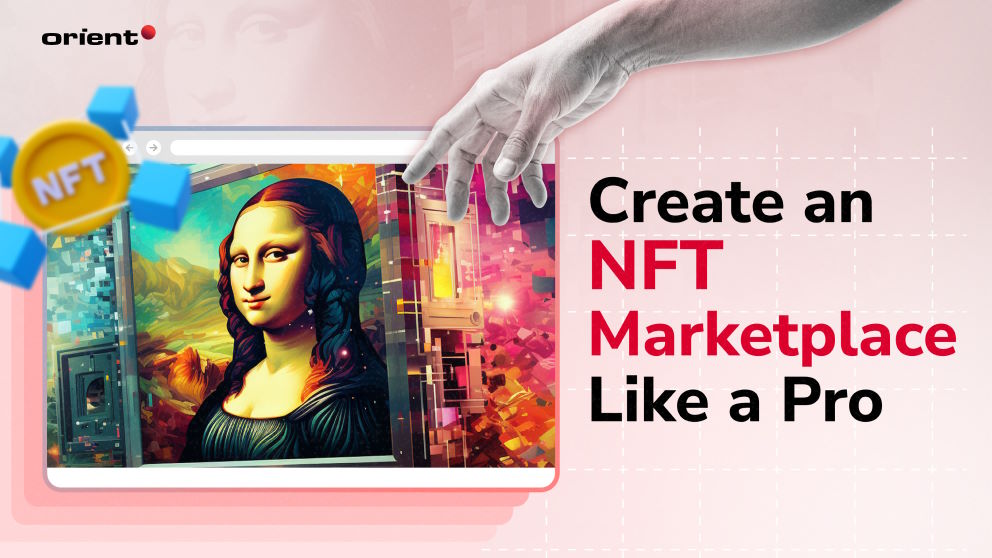NFT Marketplace Development: 7 Steps to Create an NFT Marketplace Like a Pro

Content Map
More chaptersAn online marketplace app that connects sellers and buyers through the e-commerce trading platform sounds familiar. However, have you ever heard of the “NFT marketplace” concept?
The rapid development of blockchain networks opens up today’s market to a world of possibilities, including NFT platforms. Unlike traditional marketplaces like Airbnb or Etsy that only focus on displaying and exchanging common items, NFT marketplaces are decentralized platforms where NFT creators and buyers can freely buy and sell one-of-a-kind digital assets (e.g., digital collectibles, artworks, virtual real estate, in-game items) anonymously and completely securely.
Recently, NFTs have taken the digital world by storm when appearing in most industries. In response to this increasing growth, businesses, regardless of size, are devoted to turning innovative blockchain concepts into reality and engaging with the NFT space.
While launching a unique NFT marketplace supporting users to purchase and sell NFTs is one of the popular ideas, it is vital to note that such an NFT marketplace development process requires a specific level of expertise and blockchain knowledge. The detailed instructions in this article may guide you to success.
The Growing Popularity of Digital Assets
Digital assets like NFTs have been experiencing a significant surge in popularity in recent years. According to predictions from experts, revenue in the NFT market will reach US$1,601.00m by the end of 2023. Appearing in most traditional industries, the rise of NFTs has reshaped and revolutionized the way individuals and companies perceive and trade digital assets. There are many reasons to explain this.
One of the key drivers behind the immense popularity of NFT is its potential to provide a new era of digital ownership experiences. With the help of blockchain technology, the NFT marketplace serves as both a trading space and a digital playground for speculators and collectors to securely prove ownership and authenticity of digital assets. Creators worldwide can now monetize their work and establish relationships with their audiences and peers directly, eliminating barriers of geographical distance and language.
The evolving development of NFTs is also the most apparent evidence, attributing to the growing adoption and acceptance of digital assets, cryptocurrency, and blockchain networks. The art world has embraced NFTs, with collectors and artists leveraging blockchain platforms like Ethereum to buy and sell NFT-based artwork.
Thanks to NFT’s decentralized nature, users are free to trade without being controlled by any central authority, eliminating the role of intermediaries. Greater transparency, faster transaction time, and other factors make the NFT marketplace a more attractive choice than traditional assets.
How Does an NFT Market Work?

As NFTs (non-fungible tokens) represent distinct digital assets that do not allow users to trade directly or through any crypto exchange, people need a special platform called the NFT marketplace platform to push NFTs to their limit.
An NFT marketplace is a platform where users from around the world can store, display, trade, and sometimes create their own non-fungible tokens (NFTs), which represent unique digital goods. The operating mechanism of this market has certain similarities and differences compared to conventional online marketplaces or e-commerce platforms.
Here is a breakdown of how an actual NFT marketplace typically works:
- Listing NFTs: Sellers list their NFTs for sale on the marketplace. This phase may include required steps such as providing relevant information (e.g., NFT title, description, price) and setting the terms of the sale.
- Wallet Integration: Each NFT marketplace integrates with different cryptocurrency wallets. That’s why buyers need a compatible wallet to conduct transactions, securely store NFTs, and receive ownership of purchased NFTs.
- Buying NFTs: Buyers sift through the available NFT listings, view details about the NFT (e.g., its creator, ownership history, related media), and make NFT transactions. After completing payment using cryptocurrency, the purchased NFT will be transferred to the buyer’s digital wallet.
- Auctions and Bidding: Some NFT marketplaces even offer an auction feature. The bidding process takes place like a real auction website. Sellers start bidding on their NFTs, potential buyers place bids, and the highest bidder wins the NFT at the end of the auction.
- Community and Discovery: NFT marketplaces may also act as a miniature community where users can interact, discuss, and discover new NFTs and artists thanks to features such as social profiles, comments, etc.
Examples of Leading NFT Marketplaces
To better understand the concept of the NFT marketplace, you can refer to some popular names below.

OpenSea
OpenSea is the world’s largest NFT marketplace where users can create, access, and buy various types of digital assets represented as NFTs. More than simply a digital platform, it has long become a central hub for collectors, artists, and enthusiasts involved in the NFT ecosystem.
NFTs on OpenSea range from digital art and collectibles to virtual land and more. With a user-friendly interface, the marketplace is easy to use and suitable for all types of users, facilitating the discovery and acquisition of unique digital goods.
Rarible
Rarible is another popular NFT marketplace that allows creators to mint (turn digital files into NFTs) and sell their digital assets. As a community-governed NFT protocol, it offers a decentralized approach to the NFT creation and exchange and a reliable platform for creators to issue and sell custom digital assets representing their ownership.
Not only does Rarible provide a safe trading platform for users, but it also focuses on reward mechanisms in the form of governance tokens or other incentives to encourage active participation by both artists and collectors. It is innovation and reliability that have helped improve Rarible’s engagement and value proposition.
SuperRare
SuperRare is a digital marketplace that allows artists from around the world to create unique NFT artworks. Unlike some current NFT markets that display a large number of diverse mass-market NFTs from many sources, SuperRare only focuses on selling rare digital artworks created by talented artists.
As a suitable place for collectors wishing to discover and own exclusive digital art pieces, SuperRare pays special attention to two factors: authenticity and scarcity. Each work, before being posted on the platform is carefully crafted and verified by the artist to ensure originality, helping both artists and collectors feel confident and secure when using the marketplace.
NFT Marketplace Development Process: How to Build Your Own NFT Marketplace

Developing your own NFT marketplace project is not an easy task, as it requires a high level of technical expertise and familiarity with blockchain technology. In addition to careful planning and consideration at each single step, businesses must also master the NFT marketplace development process to ensure successful outcome delivery. Here is a general overview of the steps involved in creating an NFT marketplace.
Step 1: Choose a Blockchain Architecture
Blockchain architecture lays the foundation of every digital market. When it comes to building NFT marketplaces, there are two main options you can consider, including creating your own network and using an existing one. Both approaches have their pros and cons, and the final choice depends entirely on the needs of each project.
While developing your own NFT marketplace architecture enables complete control and customization over the technology stack, it requires significant expertise and resources. The development team now has two independent development processes, which have doubled their workload, leading to burnout. Besides, starting things from scratch also means accepting a smaller user base and reduced network effects compared to established blockchain networks.
Using an established blockchain network such as Ethereum, Binance Smart Chain, or Solana offers advantages in terms of cost, user base, security, scalability, community support, and existing infrastructure. However, businesses have to make trade-offs in terms of customization and control.
Step 2: Decide Between an Open or Closed Market
The type of marketplace, whether open or closed, plays an important role in shaping the dynamics and user experience within an ecosystem. In other words, they are the deciding factor in how users and artists interact with the NFT marketplace.
If you need to create a digital market where all artists and collectors are accessible without restrictions, an open marketplace is the ideal choice for you. Conversely, if you want to create a playground that exclusively features established artists and well-known creators who provide high-quality artworks based on certain criteria, then it would be wise to opt for a closed marketplace instead.
However, it is not necessary to make a rigid choice between the two types of marketplaces mentioned above. The reason for this is the emergence of the hybrid approach that combines elements of both types, striking a balance between openness and quality control.
Step 3: Define the Marketplace Features
Besides some of the basic features required in all NFT marketplaces, such as user profiles, searching capabilities, digital wallet integration, auction systems, and transaction management, consider adding unique and innovative features that set your platform apart from competitors and attract users.
Businesses can develop advanced features like fractional capabilities to help users own a fraction of an NFT and make high-value artworks more accessible or introduce gamified elements right on the marketplace to incentivize participation and encourage users to engage more actively with the platform. Some other options include royalty mechanisms, social features, curated collections, augmented reality (AR) integration, etc.
Step 4: UI/UX Design
Typically, customers only spend the first three to five seconds on a certain website before considering leaving. That is why a user-friendly interface is an indispensable component that helps retain and motivate users to stay loyal to the NFT marketplace.
An engaging NFT marketplace design includes a wide range of elements that contribute to an immersive experience, such as attractive visual design, high-quality images and descriptions, intuitive user interface (UI), etc. Despite the types of NFT marketplaces, businesses are advised to keep the NFT marketplace design straightforward and responsive while focusing on the customer-centric approach.
As market trends and user behavior tend to change over time, make sure you are always ready to receive feedback from artists and collectors and iterate on the design for better engagement.
Step 5: Smart Contract Development
Smart contracts are self-executing contracts that are coded on blockchain networks and written by specialized programming languages. They include a set of predefined conditions and rules that govern the NFT behavior and automate various aspects of transactions.
There are many reasons why companies have to develop a smart contract. Firstly, it facilitates the creation and minting of NFTs for creators wishing to tokenize their unique assets. Secondly, it ensures every transaction on the NFT marketplace occurs securely and transparently on the blockchain. Furthermore, smart contracts can include additional functionality to provide royalties to creators.
During the process of building a smart contract, in addition to security being the top priority, pay close attention to some other important aspects, such as token standards, ownership and transfer mechanisms, scalability, and upgradability, to ensure the development of a marketplace that meets the needs of both buyers and sellers. As this process requires technical skills and specialized knowledge, you can consider partnering with an NFT marketplace development company for quality commitment.
Step 6: Integration of Payment Systems
Setting up payment gateways involves integrating payment options into your NFT marketplace. Some popular names for NFT marketplaces include BitPay, Circle, Coinbase Commerce, and CoinGate. Consider factors related to transaction fees, security, and user experience when selecting payment gateways. Integrating robust payment systems helps enhance user satisfaction and facilitates smooth transactions between buyers and sellers.
Regarding payment options, businesses are not required to use only cryptocurrency payments such as Bitcoin (BTC) or Ethereum (ETH). On the contrary, it would be wise to add support for fiat currency payments like PayPal or Apple Pay to serve users who prefer using conventional payment methods better.
Step 7: Testing and Launch
Everything is on a good track. It is time to involve thorough testing and then publish the actual launch. As the NFT marketplace revolves around aspects related to digital assets and intellectual property rights, performing types of comprehensive testing is extremely important for both users and business owners.
Specifically, companies need to conduct functional testing through various user scenarios to ensure features operate smoothly without errors, network security testing to identify and address any cybersecurity risks, load testing to assess the marketplace’s performance under high loads, etc.
After completing the necessary troubleshooting process, you can launch the NFT marketplace and promote it through various marketing channels. Regularly supporting and maintaining the software product after its launch is also an indispensable factor to ensure smooth operation.
Outsourcing Your NFT Marketplace Development with Orient Software
It is undeniable that NFTs and digital assets have seen a surge in popularity in recent years. However, there are still challenges and risks with this emerging asset class, such as potential scams, market volatility, environmental impacts, etc., that need to be navigated. The business’s job is to continue to apply and facilitate the further development of blockchain technology in the future.
As developing a custom digital market is more than a daunting task, companies may consider using NFT marketplace development services to have a stronger commitment to quality. Regardless of the blockchain software development types, Orient Software can help. By leveraging our customers’ inherent strengths and applying state-of-the-art development tools, we propose a blockchain solution that meets your unique requirements. Contact us for reliable NFT development services and more.







